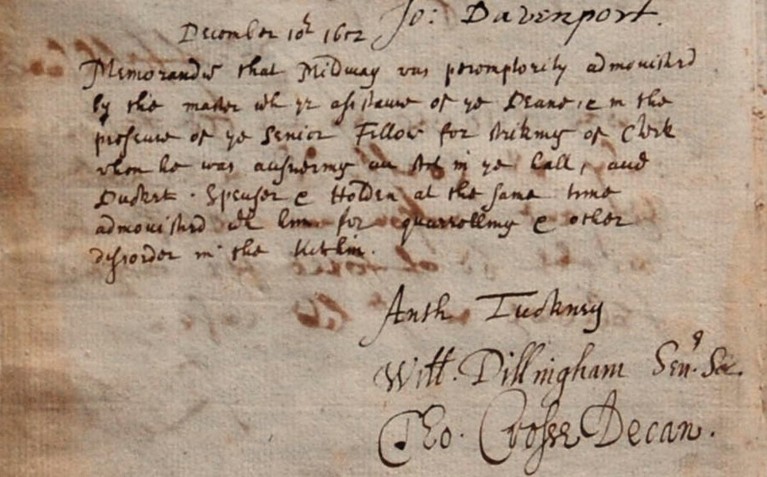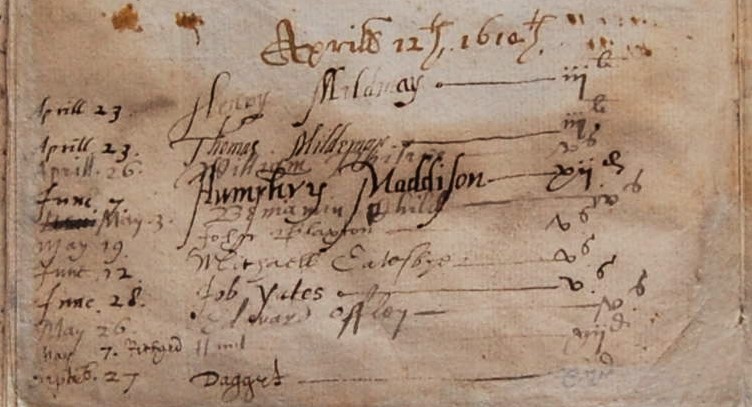Blog
28 February 2024
The London Overground map is undergoing a revamp. Its wandering orange lines will be replaced by new colours and names denoting the six segments that make up the system. The route between Stratford and Clapham Junction/Richmond has been designated the ‘Mildmay Line’, sparking considerable interest among Emma Members.
The route’s name commemorates the Mildmay Mission Hospital, founded in 1877. Since 1988, it has been a specialist centre for patients with HIV. The hospital was one of many charitable organisations set up by Canon William Pennefather and his wife Catherine, who lived in an area of Newington Green known locally as the Mildmay estate. This quarter had been developed for housing in the mid-nineteenth century, and the ubiquity of ‘Mildmay’ in the resulting nomenclature – Street, Road, Avenue, Grove, Park – is a sure indication that the land had formerly belonged to a family of that name.
Henry Mildmay’s signature in the college admission book; Thomas Mildmay, admitted on the same day, was his cousin
Henry Mildmay, born c.1594, was a grandson of Emmanuel’s Founder, Sir Walter Mildmay. Admitted to Emmanuel in 1610, he continued to take an interest in college affairs after graduating. In 1627, for example, he opposed the royal mandate suspending the unpopular De mora statute that forced Emmanuel Fellows to leave after ten years and become beneficed clergymen. Henry offered to present the college with ‘five or six’ benefices to which its Fellows could be appointed, on condition that the suspension was revoked. The King agreed, but cannily insisted that the college got the benefices first. Henry failed to deliver.
Knighted in 1617, Sir Henry was MP for Maldon from 1621 and held several important official posts, including Master of the King’s Jewel House. His rapacity regarding the perks of office was notorious. Originally a royalist, he switched allegiance during the Civil War and attended Charles I’s trial, although he stopped short of signing the King’s death warrant. He was nevertheless sentenced to life imprisonment at the Restoration; his estates were forfeit, and he was exiled to Tangiers, where he died in 1668. Given his cupidity, Sir Henry had naturally sought a wealthy bride. The lucky lady was Anne, daughter and co-heiress, with her sister Margaret, of William Halliday, a vastly wealthy London alderman. Henry enlisted the help of the King, no less, to coerce the girl’s suspicious father into permitting the betrothal, which took place in 1619.
William Halliday had a house and copyhold estate in the village of Newington Green, and it was this property that became known as the Mildmay estate. Exactly when the Mildmays acquired full possession of the land is unclear. Sources state variously that it was after Halliday’s death (1624), or his widow’s death (1646), or Anne Halliday’s death (1657). The estate had presumably been divided between the sisters, as Margaret Halliday bequeathed her Newington copyholds to her nephew, Henry Mildmay junior, in 1673.

Henry Mildmay junior’s admonition for ‘striking of Clerk’ (either John Clarke or Samuel Clarke, sizars)
Henry junior followed his father to Emmanuel, being admitted in 1651. The apple may not have fallen far from the tree, as he was ‘admonished’ in December 1652 for hitting another student (the only founder’s kin to receive this formal censure) and was later accused by his elder brother William of having cheated him out of his inheritance. The Mildmay estate in Newington remained in the hands of Henry junior’s descendants until its sale in the late 1850s.
Surviving documentation suggests that, against all the odds, the marriage between Sir Henry Mildmay and his ‘so good a wife’ Anne Halliday was a happy one. Parents to six children, they founded their own ‘Mildmay line’, and gave their name to a little corner of north London. Something to ponder when rattling between Dalston Kingsland and Canonbury…
Amanda Goode, College Archivist

